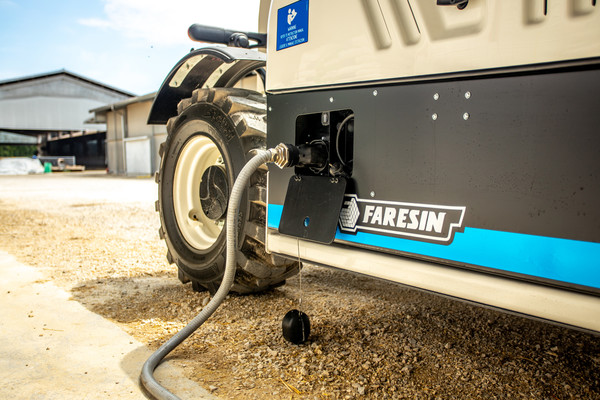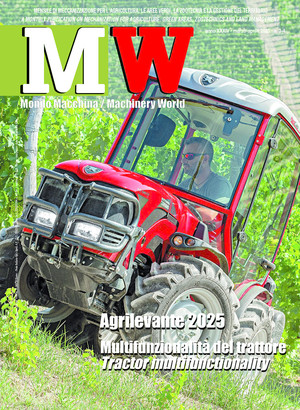
Electric: the possible transition
Agriculture is considered a complex sector to convert. But there are segments - from greenhouses to barns, including municipal work - where progress is faster. The most common electric machines and their uses
According to the 2022-23 report by the European manufacturers' association CEMA, electric vehicles accounted for a maximum of 5% of the market in that year. The most reliable estimates attribute a growth rate of between 13 and 18% per annum to this specific segment, which would lead to almost 5,000 registrations today, compared to just over 3,000 three years ago. A further increase could result from public incentive policies, should it be decided to proceed in this direction. In any case, several forecasts suggest that by 2030, 20% of EU registrations could be electric vehicles, with peaks of over 30% for France.
Electrification: yes, but which type? In other words, the transition has already begun, albeit at a slow pace. This is to be expected in a sector where electric vehicles face significant challenges, mainly related to energy density and the power requirements of agricultural activities. To power machines that constantly develop over 300 kW for several hours a day, high-density and stable energy sources are required. Batteries -even the best ones - have problems in both these areas, while they perform best in applications where high power is required for short periods, interspersed with moments when unused energy is recovered. Added to this is the difficulty of connecting machines that usually work far from the company premises for the whole day or even for several days to the grid. A typical case is that of a combine harvester operating on land 30 or 40 km away from the farm and left in the field overnight. Under these conditions, it would obviously be impossible to recharge hypothetical batteries. This is all the more true when we consider that harvesting machines, such as combine harvesters or even forage harvesters, deliver high power (500 kW and above) for prolonged periods.
Where to start. Harvesting machines are clearly the most difficult sector to electrify in agriculture, and in fact it is likely that this sector, together with the segment of tractors with power ratings above 200-250 Hp, will remain tied to internal combustion engines, hopefully powered by new low-impact fuels (such as HVO diesel, for example) or renewable sources such as methane or hydrogen.
However, every coin has two sides. And so, for one area – harvesting – where it will most likely not be possible to introduce electric power, there are others where the transition is much easier. These are activities that have certain well-defined characteristics: they take place over a short period of time, involve long periods of downtime between uses, and are carried out mainly, or exclusively, on farms or in other man-made environments, where charging points are always accessible. There is also a feature that, while not favoring electrification in a technical sense, makes it preferable from a health, environmental, or regulatory point of view, namely the opportunity to work with zero emissions and reduced noise in certain environments or situations. This includes all enclosed spaces, for example, or those urban or civil contexts in which agricultural machinery often operates.
Municipal work: an open door. The last reference is clearly to so-called municipal work. Cleaning green areas, collecting prunings, clearing snow, or spreading salt in city squares and streets. These are all examples of activities in which zero-emission and low-noise machines have an added advantage. They do not pollute (at least not on site), are quiet, and are popular with the population because of their green image. Operating in urban areas, they have easy access to charging points and their use is often concentrated within a few hours, so a range of about half a day is not a major limitation. In addition, they perform relatively light work, which does not put a heavy strain on the engine and does not require high power. For common activities in urban areas, 100 kW tractors are more than sufficient. In many cases, machines designed for specialized agriculture (fruit and wine growing, for example) can be used: this is precisely the segment in which, to date, there is the widest range of electric models available.
Zero emissions in greenhouses. For partly different reasons, zero on-site emissions are also desirable in greenhouses and may even be required in the near future. In this case, the interests worthy of protection are the health and peace of mind of operators, who find themselves working in an almost completely closed environment in the presence of harmful emissions. In addition, the same gases also fall on crops, albeit to a negligible extent. Given the strict health requirements imposed by large retailers, it is not unthinkable that, especially for organic or supply chain crops, the use of 'clean' machines will be imposed within a few years.
As in the case of municipal activities, the characteristics of greenhouse work also facilitate the transition: apart from a few sporadic interventions, high power is not required - once again, it remains below the 100 kW limit - and work is also carried out in an environment connected to the electricity grid, so it is entirely possible to recharge the machines, at least partially. For example, during the lunch break.
In the case of greenhouses, the "machines" are not only tractors, but also specific self-propelled vehicles, such as transplanters or harvesters. Their low power consumption - approximately 20-30 kW - makes them easy to electrify. So much so that there are already several battery-powered models on the market, as well as some that connect directly to the electricity grid via long cables.
All the new digital greenhouse tools are also electric, in addition to the more traditional irrigation systems. For example, autonomous harvesters, still at the prototype stage in Italy but already present in some European and especially Asian greenhouses. These are systems based on artificial intelligence and vision, which control robotic arms capable of picking fruit from plants without damaging them. Alongside these, there are small self-propelled robots that perform specific tasks, such as spot weeding or simply checking the condition of crops.
The barn, a "paradise" for electrified work. We have left until last the sector in which, according to the data, the energy transition is at the most advanced stage. The barn is particularly suited to the use of battery-powered machines for the reasons already described, namely concentrated use in a few hours during the day, proximity to the electricity grid, and above all the need to reduce emissions, particularly noise emissions. In this case, it is not the citizens of some historic town center who need to be undisturbed, but lactating cows. The possibility of increasing daily production per head by even a few deciliters is certainly an important incentive for an entrepreneur with a few hundred head under the shed. Even more so if the roof of the shed is topped by a photovoltaic system, which is now increasingly common in livestock farms. As many farmers testify, the panels, despite requiring a considerable investment, reduce energy bills by up to 90%, allowing for significant savings on production costs. Adding to this a substantial reduction in the cost of feeding the machines is obviously desirable, and this too - or perhaps above all - explains the attention given to non-endothermic means.
There is already a wide variety of such vehicles available. Let's start with the more specific ones: mixer wagons and feed ration management machines. All autonomous systems, known as AFS (Automatic Feeding Systems), are battery-powered. This is for convenience, because of the contemporary nature of the project, and also because of the low power requirements involved. Feeding robots have tanks with a volume of just a few cubic meters and therefore do not require many kilowatts to operate. This is especially true if, instead of mixing and cutting the ingredients, they limit themselves to a rough mixing and distribution, delegating the cutting and main mixing to stationary wagons (also powered by electricity, in this case from the grid). The same applies to so-called feed pushers, i.e., small robots that bring the feed ration closer to the trough at regular intervals. Then there are other robots with a less noble but equally essential task: keeping the aisles clean by removing manure and encouraging it to fall into the slatted floor.
However, other tools are also used around the barn. In addition to the classic small (utility) tractors, there is always either a telescopic loader or a wheel loader. For both of these vehicles, which are used for handling materials, there are battery-powered versions, which are favored due to their generally limited use during the day, making it possible to recharge them between work cycles. The same applies to mixer wagons, which are used intensively but only for two or three hours a day.
Loaders, skid steer loaders, and telescopic loaders are also a constant feature of biogas plants, which, by producing electricity, can operate them at almost zero cost. Incidentally, these plants are very often linked to one or more livestock farms, from which they obtain some of the raw materials necessary for their operation.
Of course, telescopic handlers and loaders are also often used on general farms. Cereal farms, for example, use them to move grain, collect round bales, or stack various materials. Finally, we must not forget electrified tools that have been around for years, such as forklifts and the like. These are sometimes found on farms or in agricultural machinery companies that have an internal workshop or that frequently need to move pallets and similar items. Think, for example, of fruit and vegetable companies.
Alongside these are pallet trucks, service vehicles, and mini-trucks. Use on concrete or asphalt surfaces, with frequent stops and starts, creates a consumption profile that favors electric power.
What the market offers. As we have already mentioned, there are already several electric power solutions on the market. In particular, for yard equipment. However, there is no shortage of tractors, especially specialized ones. In recent years, the orchard and vineyard segment has been particularly active in electrification, favored by the small size of the machines - which therefore consume less power - and the reduced workload typical of the sector. To date, there are more than a dozen electric models already available. Among them is the Fendt e100, which was unveiled a few months ago and is already in use in Europe. Historic names such as Antonio Carraro and New Holland (with the T3 Electric Power), Bcs (eValiant and Evanguard) and Kubota (LXe-261) are focusing on electric vehicles, not to mention Keestrack, heir to the prestigious Goldoni brand. There are also names that are little known in Italian agriculture, such as Ideanomics, Itl, Tafe Tractors and Farmtrac (two Indian brands). But Italians are also making moves, with Del Morino and Agri Eve (a Trentino-based startup that has collaborated with Pierre), which also offers remote-controlled or autonomous machines. Monarch is doing the same with MKV, and we return to well-known names in this niche.
Generally speaking, we are talking about tractors with power ratings from 40 to 70 Hp, equipped with a hydraulic system and three-point hitch with a couple of tons of lifting capacity. More than enough, as equipment, for normal orchard and vineyard activities, but also for use in urban or business settings. The autonomy is generally four or five hours. The exception is Landini's Rex4 hybrid, with an internal combustion engine and a second electric motor, with two hours of autonomy, for working under sheds or in stables.
The electric sector for mixer wagons is growing rapidly. Remaining in the field of traditional, man-driven wagons, we mention Supertino and Faresin, the latter already with three models in its range. Added to these are Zago, with electric versions in the King and Hawk ranges, and Seko, with the Pony 3W ME. There are also many autonomous mixer wagons, offered by Lely, Delaval, Gea, Hetwin, Trioliet, and Wasserbauer, to name a few of the best known. We conclude with Zitech's Robo 2.8, powered not by batteries but by a cable up to 60 meters long.
The market for telescopic loaders is also rich in offerings: all the major manufacturers now have at least one battery-powered model in their catalog, and sometimes more than one. This is the case with Faresin, for example, which now has two ranges in its Full Electric line: Small Range (represented by the 6.26 Full Electric) and Big Range, with the 14.42, 17.40, and 17.45 models.
The British company JCB offers the 525 60E, while the Italian company Merlo has three e-Worker models in its range. Among the latest manufacturers to enter the electric segment are Dieci with the Mini-Agri-e, followed by Kramer, Claas, and Manitou. The German brand, which relies on John Deere's sales network, offers the KT 144e (1.4 tons of load capacity and 4.3 meters of height), while Claas presented the Scorpion 732e two years ago, with superior performance (3.2 tons and 7 meters of elevation). The Mlt 625e model from French manufacturer Manitou, which arrived on the market last year, offers slightly lower performance.
We conclude with a category of machines that has seen a strong shift towards electric power in recent years. Loaders -and especially mini-loaders - are also used in construction, particularly in urban contexts, given their small size. It is therefore understandable that there is a focus on forms of energy that have less impact on the surrounding environment. From here, it is a short step to transferring some models to the agricultural sector, since their functions and requirements (in terms of power, capacity, and lifting height) are very similar.
A pioneer in this sector is Bobcat, for example, which has two models on the market: the T7X mini crawler loader and its wheeled counterpart, the S7X, launched in 2022 and 2023 respectively. From China comes the XC918 EV from the giant XCMG. It is more traditional than the unmistakable Bobcat, but still in the light loader segment. The same applies to two new products from CNH: the 12EV from Case IH and the W40X from New Holland. From Japan's Kubota come the RT210-2e and RT220-2e. Then there is the 5065e from Kramer and the 403e from JCB, which lifts 640 kg and, according to the manufacturer, has a range of over four hours, with a recharge time of around 120 minutes. These values are very similar to the other models mentioned and to those that, within a few months, will arrive on a market increasingly rich in sustainable solutions.
There are also drones
When talking about electric applications in agriculture, it is essential to devote at least a few lines to drones, specifically unmanned aerial vehicles (UAVs). These are battery-powered vehicles par excellence, as is well known. The novelty is that, while until a few years ago they could be used for surveying, aerial photography, and leaf vigor analysis, today they have become agricultural tools in their own right. This change in use is due to their carrying capacity, which, for some models and manufacturers (largely Chinese), exceeds 50 kg. This feature makes them suitable for distributing not only the famous beneficial insect larvae, but also fertilizers, biostimulants, and pollen for the artificial pollination of certain fruit trees. In parallel with these applications, their use is growing, although it is currently limited to contractors and large companies. Finally, it should be noted that maxi-drones would be perfect for phytosanitary treatments. However, these are currently prohibited by law.








